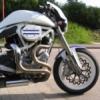Sacré histoire ce petit V8 Alu 215Ci

GM experimented with aluminum engines starting in the early 1950s, and work on a production unit commenced in 1956. Originally intended for 180-cubic-inch (2.9 L) displacement, Buick was designated by GM as the engine design leader, and decided to begin with a larger, 215-cubic-inch (3.5 L) size, which was deemed ideal for the new "senior compact cars" introduced for the 1961 model year. This group of cars was commonly referred to as the "B-O-P" group — for Buick-Olds-Pontiac — or the Y-bodies.
The 215 had a 4.24 in (107.7 mm) bore spacing, a bore of 3.5 in (88.9 mm), and a stroke of 2.8 in (71.1 mm), for an actual displacement of 3,533 cc (215.6 cu in).[citation needed] The engine was the lightest mass-production V8 in the world, with a dry weight of only 318 lb (144 kg). It was standard equipment in the 1961 Buick Special.
Oldsmobile and Pontiac also used the all-aluminum 215 on its mid-sized cars, the Oldsmobile F-85, Cutlass and Jetfire, and Pontiac Tempest and LeMans. Pontiac used the Buick version of the 215; Oldsmobile had its own. The Oldsmobile version of this engine, although sharing the same basic architecture, had cylinder heads designed by Oldsmobile engineers, and was produced on a separate assembly line. Among the differences between the Oldsmobile and Buick versions, it was somewhat heavier, at 350 lb (159 kg). The design differences were in the cylinder heads: Buick used a 5-bolt pattern around each cylinder where Oldsmobile went to a 6-bolt pattern. The 6th bolt was added to the intake manifold side of the head, one extra bolt for each cylinder, meant to alleviate a head-warping problem on high-compression versions. This meant that Oldsmobile heads would go on Buick blocks, but not vice versa, and that changing the compression ratio on an Oldsmobile 215 required changing the heads, but on a Buick 215, only the pistons, which was less expensive and simpler. For these reasons, the more common Buick version has today also emerged as more desirable. Later Rover versions of the aluminum block and subsequent Buick iron small blocks (300, 340 and 350) went to a 4-bolt-per-cylinder pattern.
At introduction, Buick's 215 was rated 150 hp (112 kW) at 4400 rpm. This was raised soon after introduction to 155 hp (116 kW) at 4600 rpm. 220 ft·lb (298 N·m) of torque was produced at 2400 rpm with a Rochester 2GC two-barrel carburetor and 8.8:1 compression ratio. A mid-year introduction was the Buick Special Skylark version, which had 10.25:1 compression and a four-barrel carburetor, raising output to 185 hp (138 kW) at 4800 rpm and 230 ft·lb (312 N·m) at 2800 rpm.
For 1962, the four-barrel engine increased the compression ratio to 10.25:1, raising it to 190 hp (142 kW) at 4800 rpm and 235 ft·lb (319 N·m) at 3000 rpm. The two-barrel engine was unchanged. For 1963, the four-barrel was bumped to 11:1 compression and an even 200 hp (149 kW) at 5000 rpm and 240 ft·lb (325 N·m) at 3200 rpm, a respectable 0.93 hp/cu in (56.6 hp/L).
Unfortunately, the great expense of the aluminum engine led to its cancellation after the 1963 model year. The engine had an abnormally high scrap ratio due to hidden block-casting porosity problems, which caused serious oil leaks. Another problem was clogged radiators from antifreeze mixtures incompatible with aluminum. It was said that one of the major problems was because they had to make extensive use of air gauging to check for casting leaks during the manufacturing process, and not being able to detect leaks on blocks that were as much as 95% complete. This raised the cost of complete engines to more than that of a comparable all cast-iron engine. Casting sealing technology was not advanced enough at that time to prevent the high scrap rates.
The Buick 215's very high power to weight ratio made it immediately interesting for automotive and marine racing. Mickey Thompson entered a stock-block Buick 215-powered car in the 1962 Indianapolis 500. From 1946 to 1962 there hadn't been a single stock-block car in this famous race. In 1962 the Buick 215 was the only non-Offenhauser powered entry in the field of 33 cars. Rookie driver Dan Gurney qualified eighth and raced well for 92 laps before retiring with transmission problems.
Surplus engine blocks of the Oldsmobile (6 bolt per cylinder) version of this engine formed the basis of the Formula One Repco V8 used by Brabham to win the 1966 and 1967 Formula One championship. No other American stock-block engine has won a Formula One championship.
Buick 215s have been engine swapped into countless sports cars, especially Chevrolet Vegas and MG sports cars. The engine remains well supported by enthusiast clubs, specialist parts suppliers, and by shops that specialize in these conversions.
The Buick 215 was used in a small sports car known as the Apollo from 1962 to 1963, and also in the Asardo 3500 GM-S show car.
Although dropped by GM in 1963, in January 1965 the tooling for the aluminum engine was sold to Britain's Rover Group to become the Rover V8 engine, which would remain in use for more than 35 years. GM tried to buy it back later on, but Rover declined, instead offering to sell engines back to GM. GM refused this offer.
 1245609349.jpg 69 Ko
113 Nombre de téléchargements
1245609349.jpg 69 Ko
113 Nombre de téléchargements  1245609394.jpg 74.17 Ko
109 Nombre de téléchargements
1245609394.jpg 74.17 Ko
109 Nombre de téléchargements  1245609428.jpg 108.8 Ko
133 Nombre de téléchargements
1245609428.jpg 108.8 Ko
133 Nombre de téléchargements  1245609484.jpg 84.05 Ko
109 Nombre de téléchargements
1245609484.jpg 84.05 Ko
109 Nombre de téléchargements  1245609567.jpg 104.22 Ko
136 Nombre de téléchargements
1245609567.jpg 104.22 Ko
136 Nombre de téléchargements

























